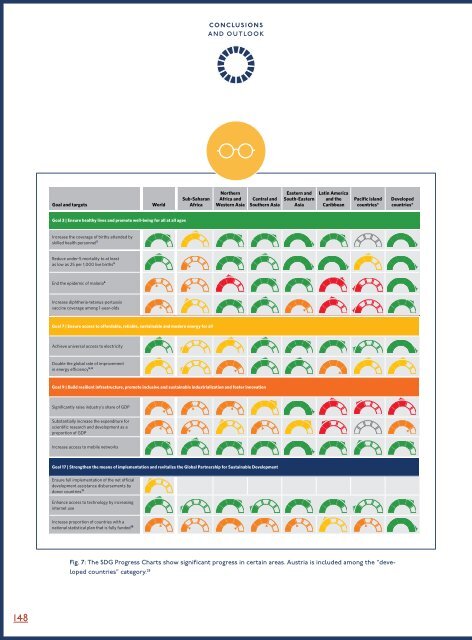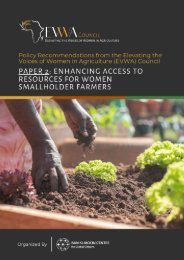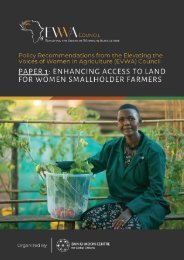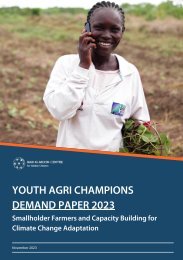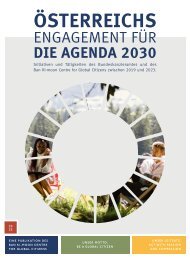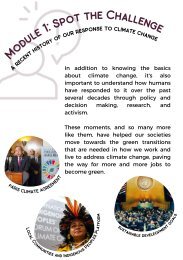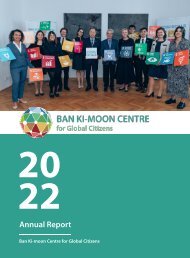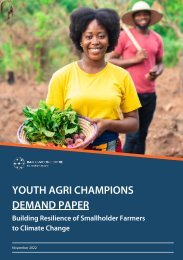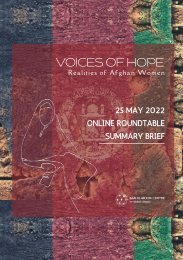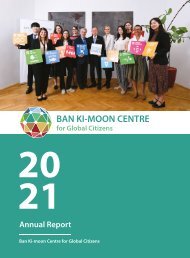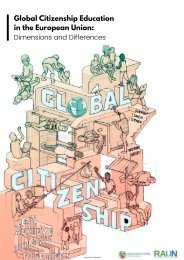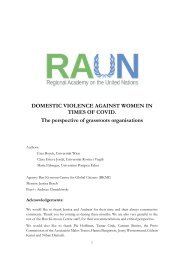Austria's Commitment to the 2030 Agenda
Guided by the BKMC's mission to foster leadership for the Sustainable Development Goals, we have been closely collaborating with the Austrian Federal Chancellery since 2018 to advance the implementation of the SDGs in and by Austria. On the margins of the UN High-Level Political Forum 2023, we are very proud to launch the Ban Ki-moon Centre for Global Citizens publication “Austria’s Commitment to the 2030 Agenda”. The publication covers national, European, and global efforts to implement the SDGs. Against the backdrop of multiple crises, it is now more important than ever to find global solutions based on cooperation, partnership, and sustainability. Dive into our report and check out milestone activities, good practice examples, and initiatives of SDG implementation in Austria from 2019 to 2023.
Guided by the BKMC's mission to foster leadership for the Sustainable Development Goals, we have been closely collaborating with the Austrian Federal Chancellery since 2018 to advance the implementation of the SDGs in and by Austria.
On the margins of the UN High-Level Political Forum 2023, we are very proud to launch the Ban Ki-moon Centre for Global Citizens publication “Austria’s Commitment to the 2030 Agenda”. The publication covers national, European, and global efforts to implement the SDGs.
Against the backdrop of multiple crises, it is now more important than ever to find global solutions based on cooperation, partnership, and sustainability. Dive into our report and check out milestone activities, good practice examples, and initiatives of SDG implementation in Austria from 2019 to 2023.
Create successful ePaper yourself
Turn your PDF publications into a flip-book with our unique Google optimized e-Paper software.
The Sustainable Development Goals Progress Chart 2021 presents a snapshot of global and regional progress <strong>to</strong>wards selected targets under <strong>the</strong> 17 Goals of <strong>the</strong> <strong>2030</strong> <strong>Agenda</strong> for Sustainable Development.<br />
The assessment is based on <strong>the</strong> most up-<strong>to</strong>-date data available. However, <strong>the</strong> full impact of <strong>the</strong> COVID-19 pandemic is not yet known. Moreover, since 2020, <strong>the</strong> pandemic has disrupted statistical<br />
operations worldwide, limiting <strong>the</strong> ability of many national statistical offices <strong>to</strong> deliver <strong>the</strong> data needed <strong>to</strong> moni<strong>to</strong>r progress on <strong>the</strong> Sustainable Development Goals (SDGs).<br />
The progress chart shows that <strong>the</strong> world was already off track in realizing <strong>the</strong> ambitions and fulfilling <strong>the</strong> commitments of <strong>the</strong> <strong>2030</strong> <strong>Agenda</strong>, even before COVID-19. As <strong>the</strong> pandemic continues <strong>to</strong><br />
unfold, it is also magnifying deeply rooted problems: insufficient social protection, weak<br />
CONCLUSIONS<br />
public health systems and inadequate health coverage, structural inequalities, environmental degradation and<br />
climate change. It is a crisis as well as an opportunity <strong>to</strong> make <strong>the</strong> transformations needed <strong>to</strong> deliver on <strong>the</strong> promise of <strong>the</strong> <strong>2030</strong> <strong>Agenda</strong>.<br />
AND OUTLOOK<br />
The progress chart presents two types of information: 1) a trend assessment using s<strong>to</strong>plight colours <strong>to</strong> measure progress <strong>to</strong>wards <strong>the</strong> target (from a baseline year <strong>to</strong> <strong>the</strong> most recent data point), and<br />
2) a level assessment using a gauge meter <strong>to</strong> measure <strong>the</strong> current level of development with respect <strong>to</strong> <strong>the</strong> distance from a target, using <strong>the</strong> latest data. The chart is based on a limited number of<br />
indica<strong>to</strong>rs and on information available as of June 2021. A baseline year of around 2015 or 2010 is used for <strong>the</strong> trend assessment. For most of <strong>the</strong> indica<strong>to</strong>rs, <strong>the</strong> latest available data are from 2019 <strong>to</strong><br />
2020; for a few indica<strong>to</strong>rs, <strong>the</strong> data are from 2017.<br />
Goal and targets<br />
World<br />
Sub-Saharan<br />
Africa<br />
Nor<strong>the</strong>rn<br />
Africa and<br />
Western Asia<br />
Central and<br />
Sou<strong>the</strong>rn Asia<br />
Eastern and<br />
South-Eastern<br />
Asia<br />
Latin America<br />
and <strong>the</strong><br />
Caribbean<br />
Pacific island<br />
countries*<br />
Developed<br />
countries*<br />
Goal 1 | End poverty all its forms everywhere<br />
Sustainable Development Goals Progress Chart 2021<br />
The Eradicate Sustainable extreme Development poverty Goals Progress Chart 2021 presents a snapshot of global and regional progress <strong>to</strong>wards selected targets under <strong>the</strong> 17 Goals of <strong>the</strong> <strong>2030</strong> <strong>Agenda</strong> for Sustainable Development.<br />
The for assessment all people everywhere is based on 1<br />
<strong>the</strong> most up-<strong>to</strong>-date data available. However, <strong>the</strong> full impact of <strong>the</strong> COVID-19 pandemic is not yet known. Moreover, since 2020, <strong>the</strong> pandemic has disrupted statistical<br />
operations worldwide, limiting <strong>the</strong> ability of many national statistical offices <strong>to</strong> deliver <strong>the</strong> data needed <strong>to</strong> moni<strong>to</strong>r progress on <strong>the</strong> Sustainable Development Goals (SDGs).<br />
The Achieve progress substantial chart shows social that protection <strong>the</strong> world was already off track in realizing <strong>the</strong> ambitions and fulfilling <strong>the</strong> commitments of <strong>the</strong> <strong>2030</strong> <strong>Agenda</strong>, even before COVID-19. As <strong>the</strong> pandemic continues <strong>to</strong><br />
unfold, coverage it is 2 also magnifying deeply rooted problems: insufficient social protection, weak public health systems and inadequate health coverage, structural inequalities, environmental degradation and<br />
climate change. It is a crisis as well as an opportunity <strong>to</strong> make <strong>the</strong> transformations needed <strong>to</strong> deliver on <strong>the</strong> promise of <strong>the</strong> <strong>2030</strong> <strong>Agenda</strong>.<br />
The progress chart presents two types of information: 1) a trend assessment using s<strong>to</strong>plight colours <strong>to</strong> measure progress <strong>to</strong>wards <strong>the</strong> target (from a baseline year <strong>to</strong> <strong>the</strong> most recent data point), and<br />
2) Goal a level 2 | assessment End hunger, using achieve a gauge food security meter <strong>to</strong> and measure improved <strong>the</strong> current nutrition level and of development promote sustainable with respect agriculture <strong>to</strong> <strong>the</strong> distance from a target, using <strong>the</strong> latest data. The chart is based on a limited number of<br />
indica<strong>to</strong>rs and on information available as of June 2021. A baseline year of around 2015 or 2010 is used for <strong>the</strong> trend assessment. For most of <strong>the</strong> indica<strong>to</strong>rs, <strong>the</strong> latest available data are from 2019 <strong>to</strong><br />
2020; for a few indica<strong>to</strong>rs, <strong>the</strong> data are from 2017.<br />
Ensure access by all people <strong>to</strong> safe, nutritious<br />
and sufficient food all year round<br />
By 2025, achieve a 40 per cent reduction<br />
from 2012 in <strong>the</strong> number of stunted children<br />
Goal under and 5 years targets 3, 4<br />
World<br />
Sub-Saharan<br />
Africa<br />
Nor<strong>the</strong>rn<br />
Africa and<br />
Western Asia<br />
Central and<br />
Sou<strong>the</strong>rn Asia<br />
Eastern and<br />
South-Eastern<br />
Asia<br />
Latin America<br />
and <strong>the</strong><br />
Caribbean<br />
Pacific island<br />
countries*<br />
Developed<br />
countries*<br />
Goal 13 | End Ensure poverty healthy in all lives its forms and promote everywhere well-being for all at all ages<br />
Eradicate Increase <strong>the</strong> extreme coverage poverty of births attended by<br />
Goal for skilled all and people health targets everywhere personnel 5 1<br />
Goal and targets<br />
World<br />
World<br />
Sub-Saharan<br />
Sub-Saharan Africa<br />
Africa<br />
Nor<strong>the</strong>rn<br />
Africa Nor<strong>the</strong>rn and<br />
Western Africa and Asia<br />
Western Asia<br />
Fig. 7: The SDG Progress Charts show significant progress 3 in certain areas. Austria is included among <strong>the</strong> “developed<br />
countries” category. 28 1<br />
Sou<strong>the</strong>rn Central and Asia<br />
Sou<strong>the</strong>rn Asia<br />
Eastern and<br />
South-Eastern<br />
and<br />
South-Eastern Asia<br />
Asia<br />
Latin America<br />
Latin and America <strong>the</strong><br />
Caribbean and <strong>the</strong><br />
Caribbean<br />
Pacific island<br />
Pacific countries* island<br />
countries*<br />
Reduce Achieve under-5 substantial mortality social <strong>to</strong> protection at least<br />
1<br />
as coverage low as 2<br />
25 per 1,000 live births 5<br />
Goal 7 | Ensure access <strong>to</strong> affordable, reliable, sustainable and modern energy for all<br />
Goal 2 | End hunger, achieve food security and improved nutrition and promote sustainable agriculture<br />
End <strong>the</strong> epidemic of malaria 6<br />
Achieve universal access <strong>to</strong> electricity<br />
Ensure access by all people <strong>to</strong> safe, nutritious<br />
Nor<strong>the</strong>rn<br />
Eastern and Latin America<br />
Increase and sufficient diph<strong>the</strong>ria-tetanus-pertussis<br />
food all year round<br />
Double <strong>the</strong> global rate of improvement<br />
Sub-Saharan Africa and Central and South-Eastern and <strong>the</strong> Pacific island<br />
vaccine<br />
in Goal<br />
By<br />
energy and coverage<br />
2025, achieve<br />
efficiency targetsamong a 40 5, 8 1-year-olds<br />
World<br />
Africa Western Asia Sou<strong>the</strong>rn Asia Asia Caribbean countries*<br />
per cent reduction<br />
from 2012 in <strong>the</strong> number of stunted children<br />
under 5 years 3, 4<br />
Goal 48 7 | Promote Ensure access inclusive sustained, <strong>to</strong> and affordable, inclusive equitable reliable, and quality sustainable sustainable education economic and promote modern growth, energy lifelong full and for opportunities productive all employment for all and decent work for all<br />
Goal 3 | Ensure healthy lives and promote well-being for all at all ages<br />
Ensure Sustain Achieve all per universal girls capita and access economic boys complete <strong>to</strong> electricity growth primary<br />
9<br />
education<br />
Increase <strong>the</strong> coverage of births attended by<br />
skilled health personnel 5 Nor<strong>the</strong>rn<br />
Eastern and Latin America<br />
Double <strong>the</strong> global rate of improvement<br />
Achieve full employment<br />
Sub-Saharan Africa and Central and South-Eastern and <strong>the</strong> Pacific island<br />
Goal in energy 5 and | Achieve efficiency<br />
targets gender 5, 8<br />
equality and empower all women Worldand girls Africa Western Asia Sou<strong>the</strong>rn Asia Asia Caribbean countries*<br />
Goal<br />
Goal<br />
98 16 |<br />
|<br />
Build Promote<br />
Promote<br />
resilient sustained,<br />
peaceful<br />
infrastructure, inclusive and<br />
and inclusive<br />
promote sustainable<br />
societies<br />
inclusive economic<br />
for sustainable<br />
and sustainable growth, full<br />
development,<br />
industrialization and productive<br />
provide access<br />
and employment foster<br />
<strong>to</strong> justice<br />
innovation and decent work for all<br />
for all and build effective, accountable and inclusive institutions at all levels<br />
Eliminate child marriage 5<br />
Significantly Sustain per capita raise reduce industry’s economic homicide share growth ratesof 14 9<br />
GDP<br />
Ensure women’s full participation and equal<br />
opportunities in national parliaments<br />
Substantially increase <strong>the</strong> expenditure for<br />
Reduce <strong>the</strong> proportion of unsentenced<br />
scientific Achieve full research employment and development as a<br />
detainees 14<br />
proportion of GDP<br />
Goal 6 | Ensure availability and sustainable management of water and sanitation for all<br />
Increase <strong>the</strong> proportion of countries with<br />
Increase independent Goal 9 | Build access national resilient <strong>to</strong> mobile human infrastructure, networks rights institutions promote inclusive and sustainable industrialization and foster innovation<br />
Achieve in compliance universal with access <strong>the</strong> Paris <strong>to</strong> Principles safely managed<br />
drinking water services 7<br />
Goal Significantly 10 17 | Streng<strong>the</strong>n Reduce raise inequality industry’s <strong>the</strong> means share within of of implementation and GDP among countries and revitalize <strong>the</strong> Global Partnership for Sustainable Development<br />
Achieve universal access <strong>to</strong> safely managed<br />
sanitation<br />
Ensure Substantially full<br />
services<br />
implementation increase 7 <strong>the</strong> expenditure of <strong>the</strong> net official for<br />
development scientific research assistance and development disbursements as a by<br />
donor proportion countries of GDP<br />
11<br />
2<br />
Enhance access <strong>to</strong> technology by increasing<br />
Increase access <strong>to</strong> mobile networks<br />
3<br />
internet use<br />
Increase proportion of countries with a<br />
national<br />
Goal 10 |<br />
statistical<br />
Reduce inequality<br />
plan that is<br />
within<br />
fully funded<br />
and among 15 countries<br />
Reduce inequality within countries 5, 10<br />
Legend<br />
Trend (colour and arrow, arrowhead)<br />
Substantial progress/on track<br />
Limited or no progress<br />
Current level<br />
Central and<br />
Developed<br />
Developed<br />
countries*<br />
countries*<br />
Developed<br />
countries*<br />
Developed<br />
countries*<br />
Reduce inequality within countries 5, 10 5<br />
Fair progress but acceleration needed<br />
Deterioration<br />
Target met<br />
or almost<br />
met<br />
Close <strong>to</strong><br />
target<br />
Moderate<br />
distance<br />
<strong>to</strong> target<br />
Far from<br />
target<br />
Very far<br />
from target<br />
Insufficient<br />
data<br />
148


